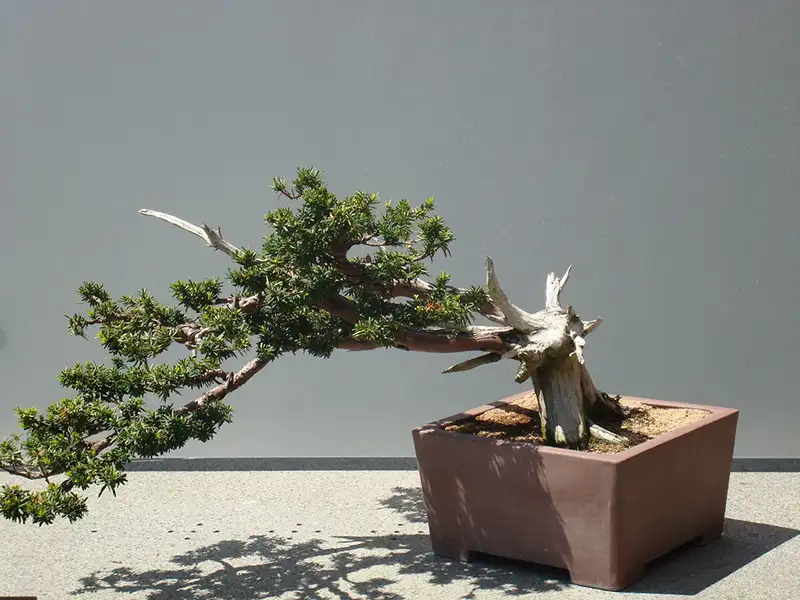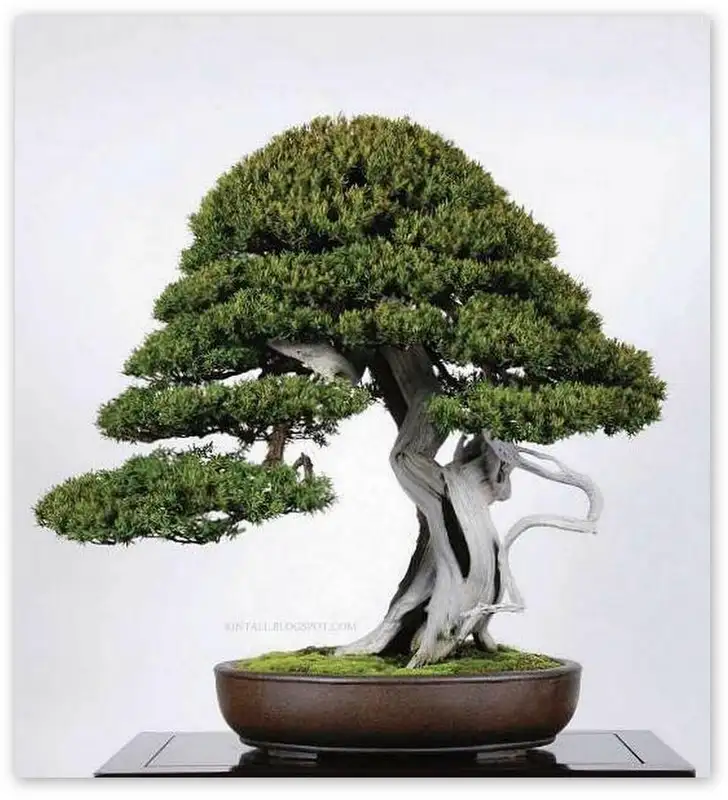Styling a Japanese Yew Bonsai
The Japanese Yew is an evergreen shrub. It has beautiful dark green, needle-shaped foliage. It is not a conifer but produces seed cones. The cones have a single seed surrounded by a berry-like red aril which is open at the end. The Japanese Yew is a great tree to make a bonsai tree with.
It is easy to develop foliage pads, and it back-buds profusely on old and new wood. This means that new branches are readily available to incorporate in your styling. Being evergreen, the Japanese Yew has an all-year-round interest.
Courtesy of 4.0 International
Sourcing a Japanese Yew
If you are looking to get a Japanese Yew bonsai tree, there are two ways to go about it:
- You can purchase an older tree that is already styled and in a bonsai pot. The upside is that it is already established and styled into a specific style. The downside is that it is normally very pricey because you pay for someone else’s time and expertise. You also do not have much say in the style and shape as these older bonsai trees are already hardwood, which is almost impossible to change.
- You can purchase a Japanese Yew from a nursery in a bag. Either as a seedling or an older tree. The younger trees can easily be shaped as more flexible greenwood. The older ones would need heavy pruning. The upside is that it is normally not so expensive, and you can shape it to your liking. The downside is that it can sometimes die with heavy pruning of roots and branches if you’re still a beginner and not experienced with Yews.
Japanese Yew Bonsai Styles
The philosophy behind bonsai tree styling is to get a tree to look as natural as possible in a miniature form. If you stand back and look at it, you must be able to see in your mind’s eye that it’s standing somewhere in a field, mountain cliff, or next to a river. But no two trees are the same. This is the fun part of bonsai. Despite the rules set by traditionalists, there isn’t a right or wrong.
You can find that inner tree by shaping it yourself. In my experience, I have found that the ugly trees in the corner of a nursery make the most beautiful bonsai with a bit of work and patience. It is as though nature appreciates the kindness you show towards that tree.
There are many Japanese Yew bonsai styles to choose from, but the basic accepted styles are:
- Formal upright style or Chokan
- Informal upright style or Moyogi
- Slanting or windswept style or Shakan
- Semi-cascade style or Han-Kengai
- Full-cascade or Kengai
- Broom style
- Exposed Root style
- Root over rock style
- Clump style
- Forest style
Styling a Japanese Yew Bonsai Tree
In my experience, the tree itself will guide you to what style you will follow. Unless it is a seedling or young sapling, which can usually be trained into any style as they’re more flexible. These young trees can normally be shaped to your desire. Shaping a Japanese Yew in a specific style can be done in two ways. The first is by pruning the branches and trunk (cut and grow method), and the next way is the wiring of the branches and trunk.
Pruning:
Styling a Japanese Yew bonsai tree can be done by pruning and carving.
- Maintenance pruning: this is done throughout the growing season. Cutting out dead wood, or branches that are too long, or came out at the wrong place or in the wrong direction. You must also remove the new buds at the end of the branches of the Japanese Yew. We normally just hold the branch with one hand and nip the butt off. Nipping off the buds is needed. Otherwise, the branches grow too long and out of shape.
- Structural pruning: this is done when you just get a tree from the nursery or just before a new growing season, and you shape it into a style that suits that specific specimen. Because all trees are so different, you might start out thinking a certain style will work well, and as you start pruning, you see that a different style will work better. Fortunately, a Japanese Yew will back-bud profusely on old and new wood. So you can prune it quite heavily, and new branches will be available soon. The Japanese Yew is also a very quick grower. So in a year, you can have a lot of new growth, making it a beautiful bonsai tree.
- Carving (Jin, Shari, or Oro): carving is where dead wood is kept or created on a bonsai tree and then carved to make a piece of art. We call this a Jin, Shari, or Oro depending on the area that is carved. Making a Jin, Shari, or Oro can be done with all the different styles. This carving of the tree becomes the focal point, but the tree must still be shaped into a style.
Wiring:
Wiring trunks and branches are very important when you shape a Japanese Yew into a specific style. You achieve the best results when the trunk and branches are still new wood. Old wood gets very difficult or near impossible to bend; wiring is used to keep the desired shape of the trunk or branch in that form. You can get different thicknesses of wires to keep different size branches in place.
The two-branch principle works well when shaping your Japanese Yew. This is done by wiring two branches with the same length of wire. Starting with one branch, returning around the trunk and around the second branch. This keeps the wire from being too loose when you wire one branch on its own.
Tools for Styling your Japanese Yew Bonsai Tree
Selecting the right tool for styling your Japanese Yew is very important. Choosing the incorrect tool can:
- Cause damage to the tree.
- Damage the tool you are using.
- Not having the specialist tool means that you can’t style the tree as you planned out.
Fortunately, there are many tools for styling bonsai trees available today. These vary in quality and price. If you are just starting, it is best to get just what you need for doing what you want to do. Purchasing the complete range of tools in one go can be very expensive. So my advice is to start with the best you can afford now. You can always buy better quality tools at a later stage. Here is a basic list to keep you started.
Tool Selection
- Sharp point scissors: maintenance pruning would need a good pair of scissors. Sharp points work well for leaves and thin branches.
- Garden shears: for structural and maintenance pruning. Especially the thicker branches.
- Branch cutter: For structural pruning, this tool is to cut thick branches when styling your tree. They make for a clean cut. Always use the back-end of the cutting surface to cut, as this is the strongest part of the tool.
The above three tools are a must. You can not start styling without any of them. The next list of tools is also important but more optional initially. It just makes your life easier.
- Knob cutter: This is nice to have but need not be in your starter kit. It is used to hollow out the cut after a branch cutter is used. It makes for greater healing of the cut.
- Small rake: used for raking out roots when you re-pot a tree.
- Pliers for wire-cutting and wiring.
- Wire: the different thickness of binding wire used for styling of branches.
Final Thoughts
Buying a Japanese Yew and styling it into a beautiful bonsai tree can be extremely rewarding. The tree is very forgiving. It is easy to regrow foliage and to grow new branches. Any mistakes that one makes will grow back readily. With a year’s styling and new growth, you can add a great Japanese Yew to your bonsai collection.








